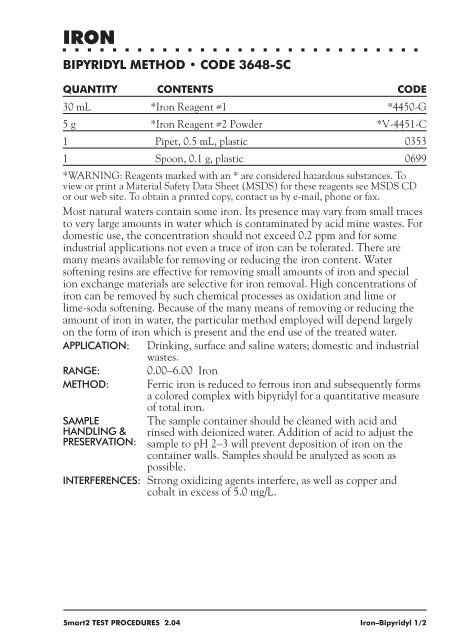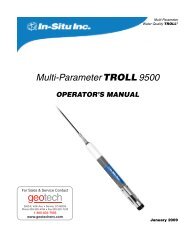TEST INSTRUCTIONS - Geotech Environmental Equipment
TEST INSTRUCTIONS - Geotech Environmental Equipment
TEST INSTRUCTIONS - Geotech Environmental Equipment
You also want an ePaper? Increase the reach of your titles
YUMPU automatically turns print PDFs into web optimized ePapers that Google loves.
IRON<br />
BIPYRIDYL METHOD CODE 3648-SC<br />
QUANTITY CONTENTS CODE<br />
30 mL *Iron Reagent #1 *4450-G<br />
5 g *Iron Reagent #2 Powder *V-4451-C<br />
1 Pipet, 0.5 mL, plastic 0353<br />
1 Spoon, 0.1 g, plastic 0699<br />
*WARNING: Reagents marked with an * are considered hazardous substances. To<br />
view or print a Material Safety Data Sheet (MSDS) for these reagents see MSDS CD<br />
or our web site. To obtain a printed copy, contact us by e-mail, phone or fax.<br />
Most natural waters contain some iron. Its presence may vary from small traces<br />
to very large amounts in water which is contaminated by acid mine wastes. For<br />
domestic use, the concentration should not exceed 0.2 ppm and for some<br />
industrial applications not even a trace of iron can be tolerated. There are<br />
many means available for removing or reducing the iron content. Water<br />
softening resins are effective for removing small amounts of iron and special<br />
ion exchange materials are selective for iron removal. High concentrations of<br />
iron can be removed by such chemical processes as oxidation and lime or<br />
lime-soda softening. Because of the many means of removing or reducing the<br />
amount of iron in water, the particular method employed will depend largely<br />
on the form of iron which is present and the end use of the treated water.<br />
APPLICATION: Drinking, surface and saline waters; domestic and industrial<br />
wastes.<br />
RANGE: 0.00–6.00 Iron<br />
METHOD: Ferric iron is reduced to ferrous iron and subsequently forms<br />
a colored complex with bipyridyl for a quantitative measure<br />
SAMPLE<br />
HANDLING &<br />
PRESERVATION:<br />
of total iron.<br />
The sample container should be cleaned with acid and<br />
rinsed with deionized water. Addition of acid to adjust the<br />
sample to pH 2–3 will prevent deposition of iron on the<br />
container walls. Samples should be analyzed as soon as<br />
possible.<br />
INTERFERENCES: Strong oxidizing agents interfere, as well as copper and<br />
cobalt in excess of 5.0 mg/L.<br />
Smart2 <strong>TEST</strong> PROCEDURES 2.04 Iron–Bipyridyl 1/2

















